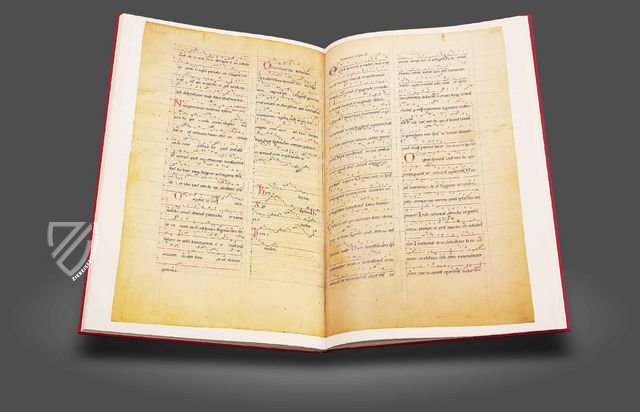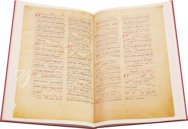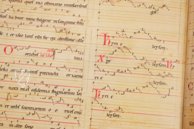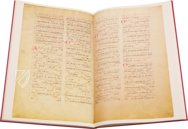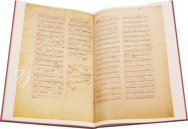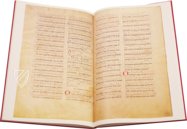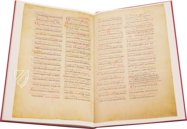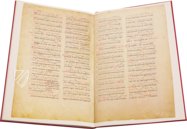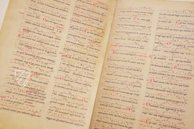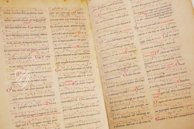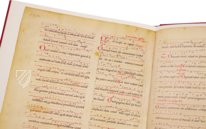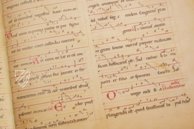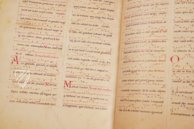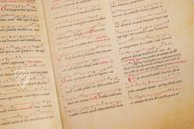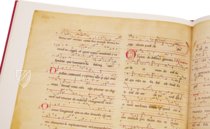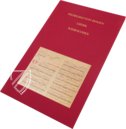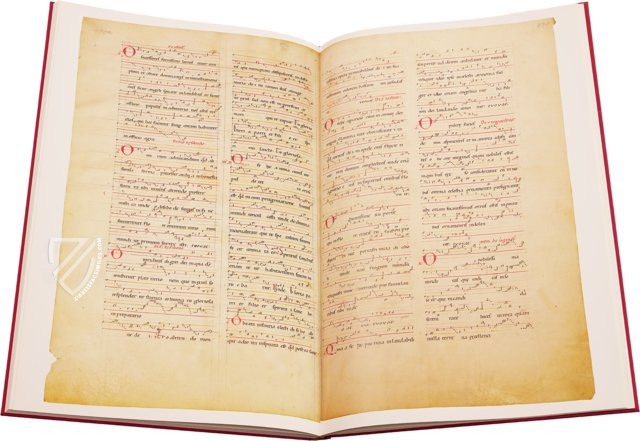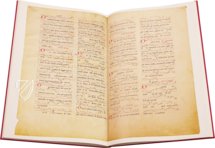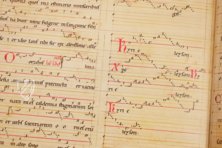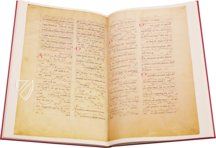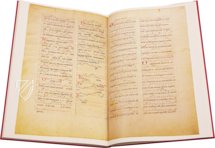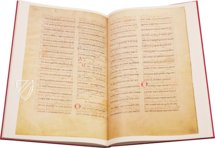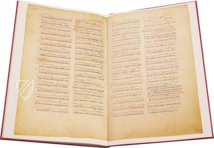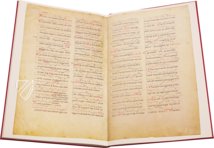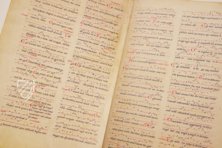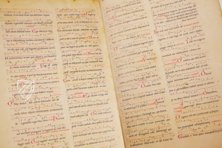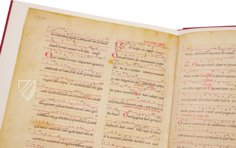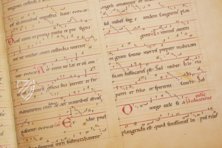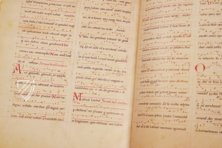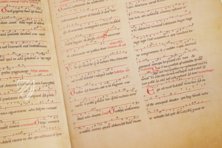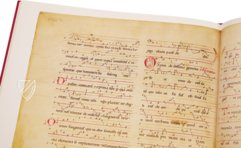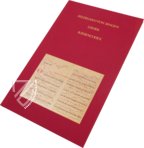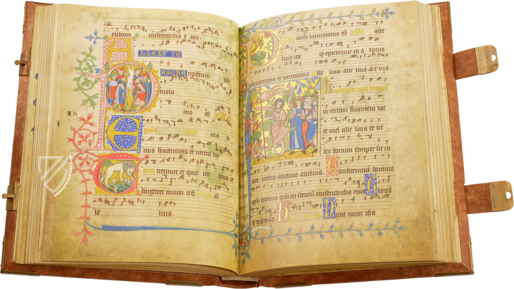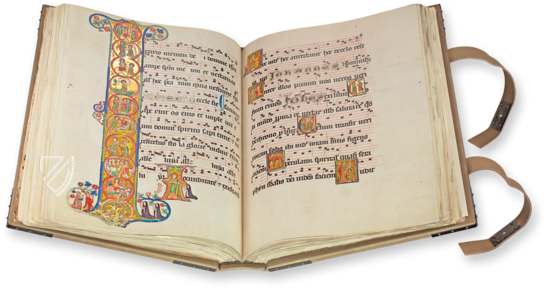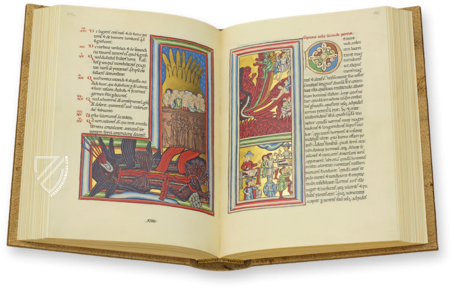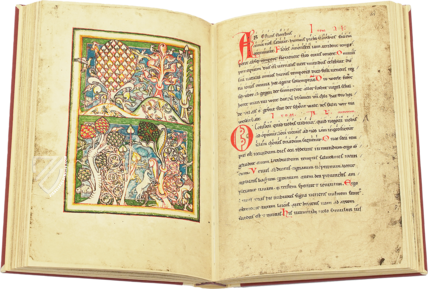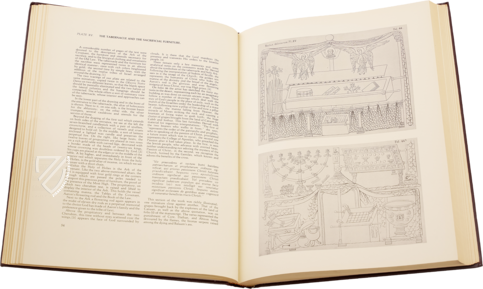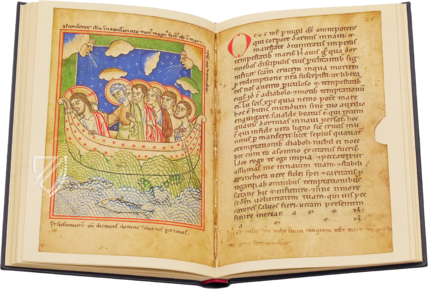Wiesbaden Codex
(under 1,000€)
Referred to in German as the Riesencodex or “giant codex” due to its size and weight – 15 kilograms, 481 folios, secured with an iron chain, and measuring 30 x 45 cm – the Wiesbaden Codex is an encyclopedia comprising the collected works of the famous medieval polymath and visionary Hildegard von Bingen. It is named after its modern repository in Wiesbaden, Germany. Only her medical writings and some of her letters are missing from the manuscript, work on which was likely started at the end of her life or shortly after her death in 1179. The manuscript was originally designed by Volmar, Hildegard’s first secretary, but was heavily edited and then executed by Guibert of Gembloux, her final secretary. These changes are apparently in accordance with Hildegard’s wishes in her final days. The work of several scribes can be discerned from the text, which is neatly written using red and black ink in two columns. This facsimile contains the section of the original manuscript, which is dedicated to Hildegard's musical compositions.
Wiesbaden Codex
The massive tome stored under the shelf mark Hs. 2 of the Hessian State Library, which was incorporated into the library of the RheinMain University of Applied Sciences in 2011, is the most precious and valuable book in the collection because it contains the collected works of the medieval German abbess, polymath, and visionary Hildegard von Bingen, except for her medical and scientific treatises. It has been theorized that these were recorded in a second volume that has not survived or was ever complete. Dating from the late 12th century, it was begun around or just after the end of her life and was created in the scriptorium of Rupertsberg Monastery near Bingen.
Many consider the manuscript to be a relic and icon of the spirit of Saint Hildegard. It is sometimes referred to as the Wiesbaden Codex because of where it is stored, or the Giant Codex due to its size, or the Chain Codex for the iron chain that secures it. Measuring 46 x 30 cm, the codex contains 481 parchment folios and weighs 15 kg, but the facsimile presented here contains the musical section found on folios 466-481.
History of a Book Treasure
The codex was commissioned by one of Hildegard’s final secretaries, either Volmar von Disibodenberg or Guibert of Gembloux, who are also believed to have served as scribes. It was kept in the Rupertsberg Monastery until the 15th or 16th century, when it was rebound in the Johannisberg Monastery in the Rheingau region and fitted with its iron chain to secure it against theft before being returned to Rupertsberg. During the Thirty Years’ War, it was saved from destruction at the hand of marauding Swedish troops when it was brought together with a collection of relics received as gifts or collected by Hildegard to Eibingen, a daughter monastery of Rupertsberg.
During the course of Secularization, the manuscript passed into the possession of the Duchy of Nassau in 1814 and was placed in the Nassau State Library, which became the Hessian State Library. Its binding had to be repaired after the manuscript was damaged while being transported in 1928. It survived the Second World War undamaged despite being stored in Dresden and, unlike many other manuscripts in the Soviet Zone of occupation, was returned to Wiesbaden in 1948.
Codicology
- Alternative Titles
- Rupertsberger Riesencodex
Riesencodex
Hildegard von Bingen: Lieder
Symphonia armonie celestium revelationum
Ordo virtutum
Kodex mit der Kette
Hildegard von Bingen - Rupertsberger Riesencodex
Grosser Hildegard-Codex
Giant Codex - Size / Format
- 962 pages / 46.0 × 30.0 cm
- Origin
- Germany
- Date
- Ca. 1180–1190
- Epochs
- Style
- Genre
- Language
- Illustrations
- Numerous red initals
- Content
- Symphonia and Ordo virtutum
- Artist / School
- Hildegard von Bingen (author)
Wibert von Gembloux (scribe?)
Volmar von Disibodenberg (scribe?)
Wiesbaden Codex
O Jewel Resplendent
A large red “O” initial with a flourish in the middle introduces the phrase “O splendidissima gemma” and the abbreviated red text to the right stands for A(ntiphona) d(e) S(ancta) Maria. In the final vision of her Liber Scivias, Hildegard hears celestial choirs singing in praise of the Virgin Queen of Heaven and this antiphon found on fol. 466v is the first piece in that heavenly symphony. Its opening image is that of a gemstone refracting sunlight, which literally becomes a lens through which Hildegard glimpses the entirety of salvation history.
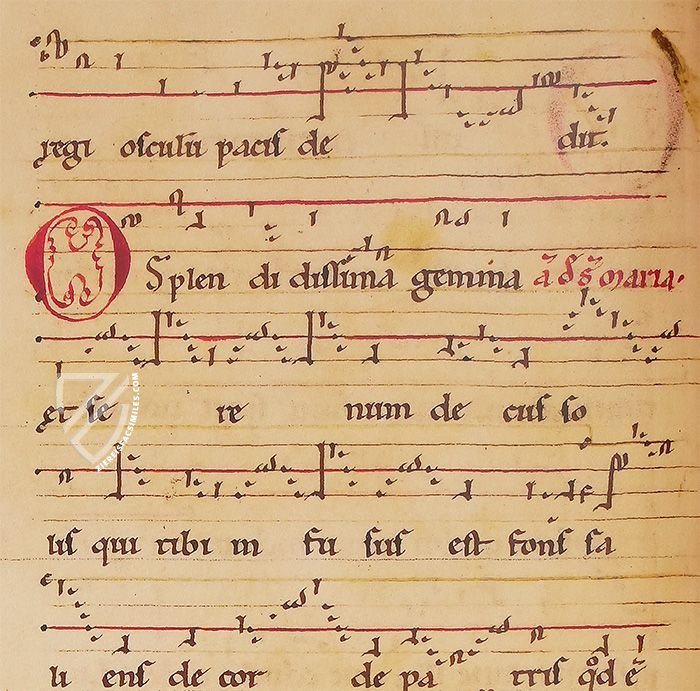
Wiesbaden Codex
Fol. 472r
The antiphons in the left column of this page are a continuation of a cycle concerning Saint Ursula. According to the Roman Martyrology, she was a Romano-British Christian princess accompanied by 11,000 virginal handmaidens on pilgrimage to Rome who, upon their return journey to Gaul where she was to be married, were all killed by Huns besieging Cologne in the year 383. The right column contains two more antiphons, one devoted to the Holy Innocents and the other used for the official Dedication of churches.
This page is the work of a skilled scribe who has also been identified as being one of the hands that created the Scivias manuscript, which means it is undoubtedly the work of the scriptorium in the cloister at Rupertsberg. Featuring 17 “systems” or ensemble staves in red and brown ink per column, the page is neatly and clearly designed so that both the notation and the text are clearly visible. If anything, the scribe left an abundance of space in the margins.
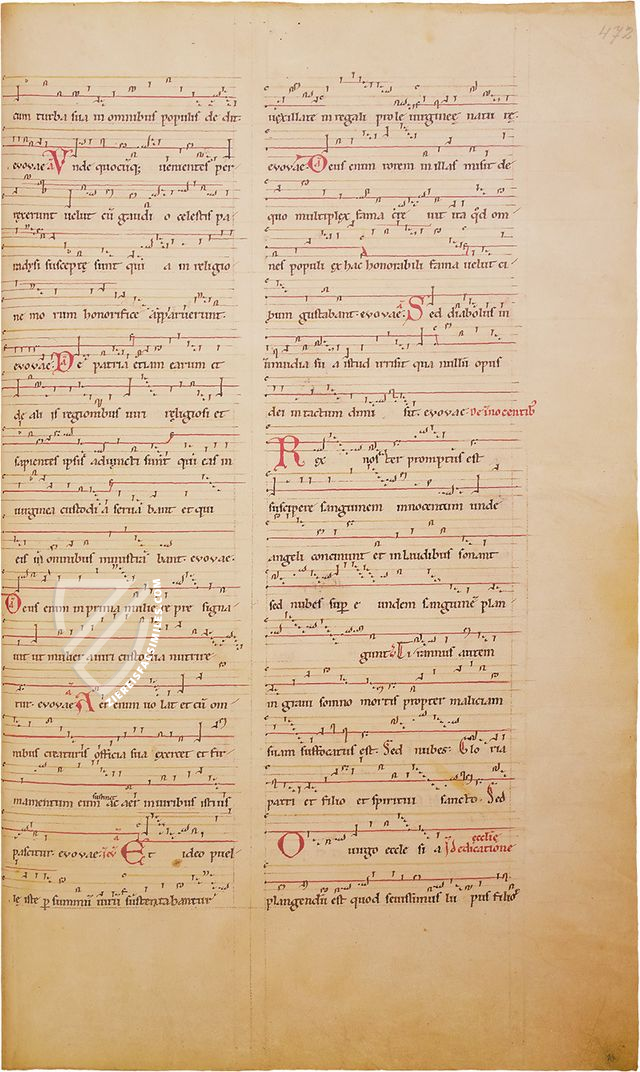
#1 Hildegard von Bingen: Lieder
Languages: English, German
(under 1,000€)
- Treatises / Secular Books
- Apocalypses / Beatus
- Astronomy / Astrology
- Bestiaries
- Bibles / Gospels
- Chronicles / History / Law
- Geography / Maps
- Saints' Lives
- Islam / Oriental
- Judaism / Hebrew
- Single Leaf Collections
- Leonardo da Vinci
- Literature / Poetry
- Liturgical Manuscripts
- Medicine / Botany / Alchemy
- Music
- Mythology / Prophecies
- Psalters
- Other Religious Books
- Games / Hunting
- Private Devotion Books
- Other Genres
- Afghanistan
- Armenia
- Austria
- Belgium
- Belize
- Bosnia and Herzegovina
- China
- Colombia
- Costa Rica
- Croatia
- Cyprus
- Czech Republic
- Denmark
- Egypt
- El Salvador
- Ethiopia
- France
- Germany
- Greece
- Guatemala
- Honduras
- Hungary
- India
- Iran
- Iraq
- Israel
- Italy
- Japan
- Jordan
- Kazakhstan
- Kyrgyzstan
- Lebanon
- Liechtenstein
- Luxembourg
- Mexico
- Morocco
- Netherlands
- Palestine
- Panama
- Peru
- Poland
- Portugal
- Romania
- Russia
- Serbia
- Spain
- Sri Lanka
- Sweden
- Switzerland
- Syria
- Tajikistan
- Turkey
- Turkmenistan
- Ukraine
- United Kingdom
- United States
- Uzbekistan
- Vatican City
- A. Oosthoek, van Holkema & Warendorf
- Aboca Museum
- Ajuntament de Valencia
- Akademie Verlag
- Akademische Druck- u. Verlagsanstalt (ADEVA)
- Aldo Ausilio Editore - Bottega d’Erasmo
- Alecto Historical Editions
- Alkuin Verlag
- Almqvist & Wiksell
- Amilcare Pizzi
- Andreas & Andreas Verlagsbuchhandlung
- Archa 90
- Archiv Verlag
- Archivi Edizioni
- Arnold Verlag
- ARS
- Ars Magna
- ArtCodex
- AyN Ediciones
- Azimuth Editions
- Badenia Verlag
- Bärenreiter-Verlag
- Belser Verlag
- Belser Verlag / WK Wertkontor
- Benziger Verlag
- Bernardinum Wydawnictwo
- BiblioGemma
- Biblioteca Apostolica Vaticana (Vaticanstadt, Vaticanstadt)
- Bibliotheca Palatina Faksimile Verlag
- Bibliotheca Rara
- Boydell & Brewer
- Bramante Edizioni
- Bredius Genootschap
- Brepols Publishers
- British Library
- C. Weckesser
- Caixa Catalunya
- Canesi
- CAPSA, Ars Scriptoria
- Caratzas Brothers, Publishers
- Carus Verlag
- Casamassima Libri
- Centrum Cartographie Verlag GmbH
- Chavane Verlag
- Christian Brandstätter Verlag
- Circulo Cientifico
- Club Bibliófilo Versol
- Club du Livre
- CM Editores
- Collegium Graphicum
- Collezione Apocrifa Da Vinci
- Comissão Nacional para as Comemorações dos Descobrimentos Portugueses
- Coron Verlag
- Corvina
- CTHS
- D. S. Brewer
- Damon
- De Agostini/UTET
- De Nederlandsche Boekhandel
- De Schutter
- Deuschle & Stemmle
- Deutscher Verlag für Kunstwissenschaft
- DIAMM
- Droz
- E. Schreiber Graphische Kunstanstalten
- Ediciones Boreal
- Ediciones Grial
- Ediclube
- Edições Inapa
- Edilan
- Editalia
- Edition Deuschle
- Edition Georg Popp
- Edition Leipzig
- Edition Libri Illustri
- Editiones Reales Sitios S. L.
- Éditions de l'Oiseau Lyre
- Editions Medicina Rara
- Editorial Casariego
- Editorial Mintzoa
- Editrice Antenore
- Editrice Velar
- Edizioni Edison
- Egeria, S.L.
- Eikon Editores
- Electa
- Emery Walker Limited
- Enciclopèdia Catalana
- Eos-Verlag
- Ephesus Publishing
- Ernst Battenberg
- Eugrammia Press
- Extraordinary Editions
- Fackelverlag
- Facsimila Art & Edition
- Facsimile Editions Ltd.
- Facsimilia Art & Edition Ebert KG
- Faksimile Verlag
- Feuermann Verlag
- Folger Shakespeare Library
- Franco Cosimo Panini Editore
- Friedrich Wittig Verlag
- Fundación Hullera Vasco-Leonesa
- G. Braziller
- Gabriele Mazzotta Editore
- Gebr. Mann Verlag
- Gesellschaft für graphische Industrie
- Getty Research Institute
- Giovanni Domenico de Rossi
- Giunti Editore
- Graffiti
- Grafica European Center of Fine Arts
- Guido Pressler
- Guillermo Blazquez
- Gustav Kiepenheuer
- H. N. Abrams
- Harrassowitz
- Harvard University Press
- Helikon
- Hendrickson Publishers
- Henning Oppermann
- Herder Verlag
- Hes & De Graaf Publishers
- Hoepli
- Holbein-Verlag
- Houghton Library
- Hugo Schmidt Verlag
- Idion Verlag
- Il Bulino, edizioni d'arte
- ILte
- Imago
- Insel Verlag
- Insel-Verlag Anton Kippenberger
- Instituto de Estudios Altoaragoneses
- Instituto Nacional de Antropología e Historia
- Introligatornia Budnik Jerzy
- Istituto dell'Enciclopedia Italiana - Treccani
- Istituto Ellenico di Studi Bizantini e Postbizantini
- Istituto Geografico De Agostini
- Istituto Poligrafico e Zecca dello Stato
- Italarte Art Establishments
- Jan Thorbecke Verlag
- Johnson Reprint Corporation
- Josef Stocker
- Josef Stocker-Schmid
- Jugoslavija
- Karl W. Hiersemann
- Kasper Straube
- Kaydeda Ediciones
- Kindler Verlag / Coron Verlag
- Kodansha International Ltd.
- Konrad Kölbl Verlag
- Kurt Wolff Verlag
- La Liberia dello Stato
- La Linea Editrice
- La Meta Editore
- Lambert Schneider
- Landeskreditbank Baden-Württemberg
- Leo S. Olschki
- Les Incunables
- Liber Artis
- Library of Congress
- Libreria Musicale Italiana
- Lichtdruck
- Lito Immagine Editore
- Lumen Artis
- Lund Humphries
- M. Moleiro Editor
- Maison des Sciences de l'homme et de la société de Poitiers
- Manuscriptum
- Martinus Nijhoff
- Maruzen-Yushodo Co. Ltd.
- MASA
- Massada Publishers
- McGraw-Hill
- Metropolitan Museum of Art
- Militos
- Millennium Liber
- Müller & Schindler
- Nahar - Stavit
- Nahar and Steimatzky
- National Library of Wales
- Neri Pozza
- Nova Charta
- Oceanum Verlag
- Odeon
- Orbis Mediaevalis
- Orbis Pictus
- Österreichische Staatsdruckerei
- Oxford University Press
- Pageant Books
- Parzellers Buchverlag
- Patrimonio Ediciones
- Pattloch Verlag
- PIAF
- Pieper Verlag
- Plon-Nourrit et cie
- Poligrafiche Bolis
- Presses Universitaires de Strasbourg
- Prestel Verlag
- Princeton University Press
- Prisma Verlag
- Priuli & Verlucca, editori
- Pro Sport Verlag
- Propyläen Verlag
- Pytheas Books
- Quaternio Verlag Luzern
- Reales Sitios
- Recht-Verlag
- Reichert Verlag
- Reichsdruckerei
- Reprint Verlag
- Riehn & Reusch
- Roberto Vattori Editore
- Rosenkilde and Bagger
- Roxburghe Club
- Salerno Editrice
- Saltellus Press
- Sandoz
- Sarajevo Svjetlost
- Schöck ArtPrint Kft.
- Schulsinger Brothers
- Scolar Press
- Scrinium
- Scripta Maneant
- Scriptorium
- Shazar
- Siloé, arte y bibliofilia
- SISMEL - Edizioni del Galluzzo
- Sociedad Mexicana de Antropología
- Société des Bibliophiles & Iconophiles de Belgique
- Soncin Publishing
- Sorli Ediciones
- Stainer and Bell
- Studer
- Styria Verlag
- Sumptibus Pragopress
- Szegedi Tudomànyegyetem
- Taberna Libraria
- Tarshish Books
- Taschen
- Tempus Libri
- Testimonio Compañía Editorial
- Thames and Hudson
- The Clear Vue Publishing Partnership Limited
- The Facsimile Codex
- The Folio Society
- The Marquess of Normanby
- The Richard III and Yorkist History Trust
- Tip.Le.Co
- TouchArt
- TREC Publishing House
- TRI Publishing Co.
- Trident Editore
- Tuliba Collection
- Typis Regiae Officinae Polygraphicae
- Union Verlag Berlin
- Universidad de Granada
- University of California Press
- University of Chicago Press
- Urs Graf
- Vallecchi
- Van Wijnen
- VCH, Acta Humaniora
- VDI Verlag
- VEB Deutscher Verlag für Musik
- Verlag Anton Pustet / Andreas Verlag
- Verlag Bibliophile Drucke Josef Stocker
- Verlag der Münchner Drucke
- Verlag für Regionalgeschichte
- Verlag Styria
- Vicent Garcia Editores
- W. Turnowski Ltd.
- W. Turnowsky
- Waanders Printers
- Wiener Mechitharisten-Congregation (Wien, Österreich)
- Wissenschaftliche Buchgesellschaft
- Wissenschaftliche Verlagsgesellschaft
- Wydawnictwo Dolnoslaskie
- Xuntanza Editorial
- Zakład Narodowy
- Zollikofer AG

